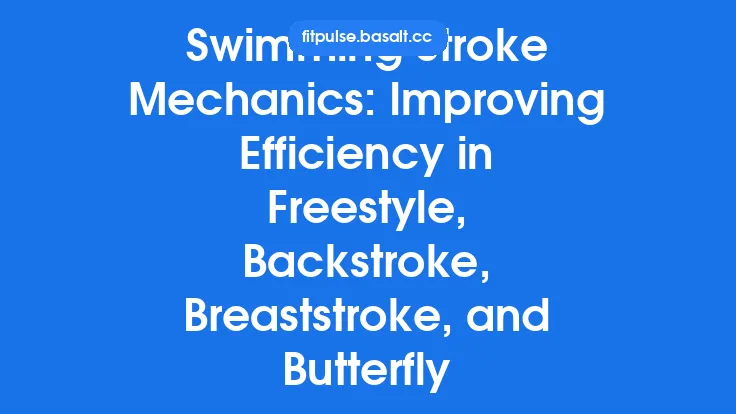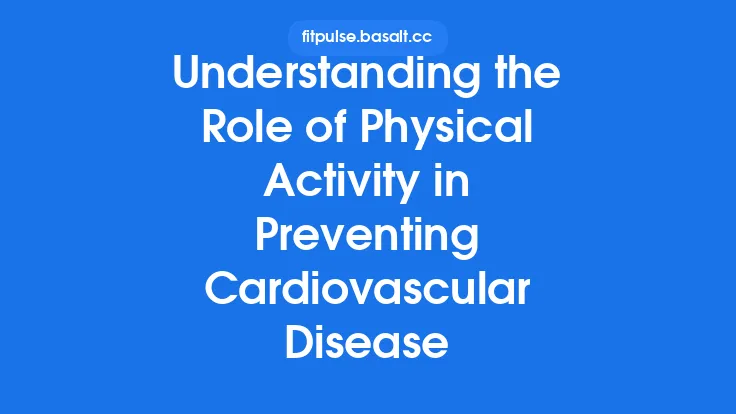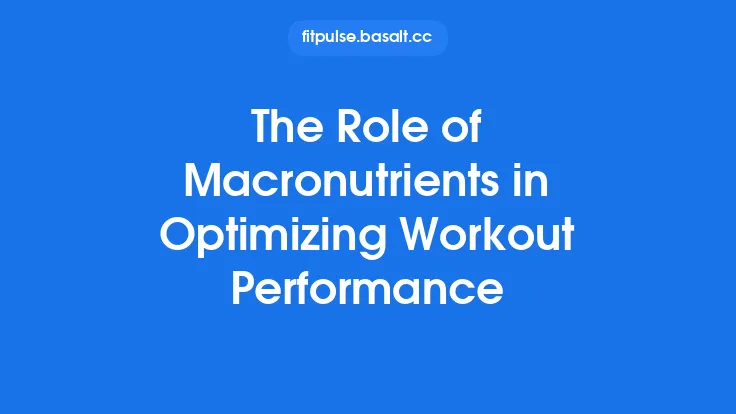Breathing is often taken for granted in endurance training, yet the way we move air in and out of our lungs can be the difference between a comfortable, sustainable effort and a premature collapse of performance. By mastering the mechanics of respiration—how the diaphragm, intercostal muscles, and accessory muscles coordinate, how airflow is regulated, and how ventilation matches metabolic demand—athletes can extract more oxygen per breath, reduce unnecessary energy expenditure, and ultimately improve aerobic efficiency. This article delves into the physiological underpinnings of breathing mechanics, explores the variables that can be trained, and provides actionable strategies for integrating respiratory optimization into any aerobic conditioning program.
The Anatomy of Efficient Ventilation
Diaphragmatic Dominance
The diaphragm is the primary driver of tidal volume (the amount of air moved per breath). When it contracts in a dome‑shaped motion, the thoracic cavity expands, creating a negative pressure that draws air deep into the lower lobes where perfusion is greatest. Training the diaphragm to initiate each breath—rather than relying on shallow, upper‑chest “clavicular” breathing—maximizes alveolar ventilation and reduces dead‑space re‑breathing.
Intercostal and Accessory Muscles
External intercostals lift the rib cage, complementing diaphragmatic descent. During higher intensities, internal intercostals and accessory muscles (scalenes, sternocleidomastoid, pectoralis minor) assist in rapid chest expansion. Efficient recruitment patterns involve a smooth transition: diaphragmatic dominance at low‑to‑moderate intensities, with progressive engagement of intercostals and accessories as ventilation demands rise.
Lung Volumes and Capacities
Understanding functional residual capacity (FRC), inspiratory reserve volume (IRV), and expiratory reserve volume (ERV) helps athletes appreciate the “breathing buffer” available during sustained effort. A well‑conditioned respiratory system can expand IRV without encroaching on ERV, preserving a stable FRC and preventing premature airway closure.
Key Respiratory Variables Influencing Aerobic Efficiency
| Variable | Definition | Impact on Efficiency |
|---|---|---|
| Tidal Volume (VT) | Volume of air per breath | Larger VT reduces breathing frequency (f) for a given minute ventilation (VE), lowering muscular work of breathing. |
| Breathing Frequency (f) | Breaths per minute | Excessive f increases dead‑space ventilation and elevates CO₂ re‑breathing, impairing arterial O₂ saturation. |
| Minute Ventilation (VE) | VT × f (total air moved per minute) | Must match metabolic CO₂ production; overshooting VE wastes energy, undershooting limits O₂ delivery. |
| Ventilatory Threshold (VT₁) | Point where VE rises disproportionately to VO₂ | Delaying VT₁ through efficient mechanics postpones reliance on anaerobic buffering. |
| Respiratory Muscle Strength (RMS) | Maximal inspiratory/expiratory pressures | Stronger RMS reduces perceived effort at a given workload, preserving cardiac output for locomotor muscles. |
| Breathing Reserve (BR) | (MVV – VE) / MVV × 100% (MVV = maximal voluntary ventilation) | Higher BR indicates capacity to increase ventilation during spikes without compromising form. |
The Physiology Behind Breathing Efficiency
- Alveolar‑Capillary Matching – Deep diaphragmatic breaths preferentially fill the basal alveoli, which receive the greatest perfusion due to gravity‑driven blood flow. This optimizes the diffusion gradient for O₂ and CO₂, raising arterial oxygen content (CaO₂) without increasing cardiac output.
- Reduced Work of Breathing (WOB) – The respiratory muscles consume ~5–10% of VO₂ at rest, rising to 15% or more at high intensities. By increasing VT and lowering f, the diaphragm operates near its optimal length‑tension curve, minimizing the metabolic cost of ventilation.
- Ventilatory Efficiency (VE/VO₂) – A lower VE/VO₂ ratio indicates that less ventilation is required for a given oxygen uptake, reflecting better gas exchange and reduced dead‑space ventilation. Efficient breathing mechanics directly lower this ratio.
- Autonomic Balance – Controlled breathing (e.g., nasal, diaphragmatic) stimulates the vagus nerve, enhancing parasympathetic tone. This can lower resting heart rate and improve heart‑rate variability (HRV), both markers of cardiovascular efficiency.
Training the Respiratory System
1. Inspiratory Muscle Training (IMT)
- Devices: Threshold loading devices (e.g., POWERbreathe) provide a calibrated resistance that the athlete must overcome on each inhalation.
- Protocol: 30 breaths twice daily at 30–50% of maximal inspiratory pressure (MIP), progressing weekly by 5% increments.
- Adaptations: Increases MIP by 10–20%, improves diaphragmatic endurance, and can shift the ventilatory threshold upward by ~5%.
2. Expiratory Muscle Training (EMT)
- Rationale: Strong expiratory muscles accelerate CO₂ clearance, especially during high‑intensity intervals where rapid exhalation is required.
- Method: Use a resistive exhalation valve or perform “forced exhalation” drills (e.g., blowing against a closed fist) for 3 sets of 10–15 seconds.
3. Diaphragmatic Breathing Drills
- Supine Diaphragm Activation: Lying on the back with a light weight on the abdomen, inhale slowly through the nose, feeling the weight rise. Exhale through pursed lips, allowing the weight to fall.
- Progression: Transition to seated, then standing, and finally moving (e.g., during a light jog) while maintaining diaphragmatic dominance.
4. Nasal vs. Oral Breathing
- Nasal Breathing Benefits: Filters, humidifies, and warms air, reducing airway resistance; promotes nitric oxide production, which improves vasodilation and O₂ uptake.
- Implementation: Begin with low‑intensity sessions (≤60% VO₂max) breathing exclusively through the nose. Gradually incorporate nasal breathing into warm‑ups and recovery periods of higher‑intensity workouts.
5. Breath‑Timing Strategies
- Cadence‑Linked Breathing: Align breaths with footstrike patterns (e.g., 2:2 for running, 2:1 for cycling) to create rhythmic, low‑effort ventilation.
- Box Breathing: Inhale 4 s, hold 4 s, exhale 4 s, hold 4 s. Useful for post‑interval recovery to reset autonomic balance and clear CO₂.
Practical Integration Into Aerobic Sessions
| Phase | Breathing Focus | Technique | Expected Outcome |
|---|---|---|---|
| Warm‑up (10‑15 min) | Diaphragmatic activation, nasal breathing | Slow, deep inhalations through the nose; pursed‑lip exhalations | Prepares respiratory muscles, lowers heart rate, primes parasympathetic tone |
| Steady‑State (30‑60 min) | Efficiency, rhythm | Cadence‑linked breathing (e.g., 3:3 for running), maintain VT ~ 12–15 ml kg⁻¹ min⁻¹ | Reduces WOB, conserves glycogen, stabilizes VO₂ |
| Interval/Tempo (≤20 min total) | Power, rapid CO₂ clearance | Switch to oral breathing during high‑intensity bursts; incorporate brief EMT bursts (forceful exhalations) between reps | Maximizes O₂ delivery, delays lactate accumulation |
| Cool‑down (10 min) | Recovery, parasympathetic shift | Return to nasal, diaphragmatic breathing; incorporate box breathing | Accelerates lactate clearance, improves HRV |
Monitoring Progress Without High‑Tech Tools
While sophisticated spirometry is valuable, athletes can track respiratory improvements using simple, repeatable measures:
- Breathing Rate at Fixed Pace: Record breaths per minute while running at a known pace (e.g., 6 min km⁻¹). A reduction over weeks indicates increased VT.
- Talk Test Calibration: At a given intensity, note whether conversation is “easy,” “moderate,” or “hard.” Improved mechanics shift the talk test toward “easy” at higher workloads.
- Perceived Breathing Effort (PBE) Scale: A 0–10 rating after a set interval. Declining scores at constant intensity reflect enhanced respiratory efficiency.
Common Misconceptions (and Why They’re Not Covered Elsewhere)
- “You must always breathe through the nose to be efficient.”
Nasal breathing is advantageous at low‑to‑moderate intensities, but during high‑intensity work the airway resistance can limit ventilation. Switching to oral breathing when VE approaches 70–80% of MVV is physiologically appropriate.
- “Holding your breath during sprints improves power.”
Breath‑holding creates intrathoracic pressure spikes that impede venous return, reducing stroke volume and overall cardiac output. Controlled exhalation during effort is far more beneficial.
- “A larger chest automatically means better breathing.”
Thoracic dimensions are less important than muscle coordination. A compact, well‑trained diaphragm can outperform a larger but poorly coordinated rib cage.
Long‑Term Benefits of Optimized Breathing Mechanics
- Enhanced VO₂max: By reducing the proportion of VO₂ devoted to respiratory muscles, more oxygen is available for locomotor muscles, nudging VO₂max upward.
- Delayed Onset of Fatigue: Lower WOB conserves glycogen stores and reduces lactate production, extending the time to exhaustion.
- Improved Recovery Kinetics: Efficient CO₂ clearance and heightened parasympathetic activation accelerate post‑exercise heart‑rate recovery.
- Injury Prevention: Stable core engagement through diaphragmatic breathing supports spinal alignment, reducing the risk of overuse injuries during high‑volume training.
Putting It All Together: A Sample 8‑Week Respiratory Conditioning Block
| Week | Focus | Sessions | Key Drill | Volume |
|---|---|---|---|---|
| 1‑2 | Baseline & Diaphragm Awareness | 3×/week | Supine diaphragmatic breathing + 5‑min nasal warm‑up | 10 min per session |
| 3‑4 | Inspiratory Muscle Strength | 2×/week IMT (30 % MIP) + 1×/week cadence‑linked run | IMT device + 2 min run at 2:2 cadence | 15 min IMT, 30 min run |
| 5‑6 | Expiratory Power & Nasal Transition | 2×/week EMT + 1×/week nasal steady‑state | Forced exhalation bursts + 45 min nasal run (≤60 % VO₂max) | 10 min EMT, 45 min run |
| 7‑8 | Integrated High‑Intensity Breathing | 2×/week interval session with breath‑switching | 4 × 4 min intervals: nasal breathing 2 min → oral breathing 2 min | 40 min total |
Progressive overload is applied to the respiratory muscles (increase resistance, add sets) while maintaining the principle of specificity: drills mirror the breathing patterns required in the athlete’s primary sport.
Final Thoughts
Breathing is the conduit through which oxygen reaches every cell and carbon dioxide is expelled—a process that, when optimized, can unlock hidden reserves of aerobic efficiency. By understanding the anatomy of ventilation, tracking key respiratory variables, and deliberately training the diaphragm, intercostals, and accessory muscles, athletes can reduce the metabolic cost of breathing, improve gas exchange, and sustain higher workloads for longer periods. Incorporating structured respiratory drills alongside regular cardiovascular training transforms breathing from a passive background function into a powerful lever for performance enhancement.





